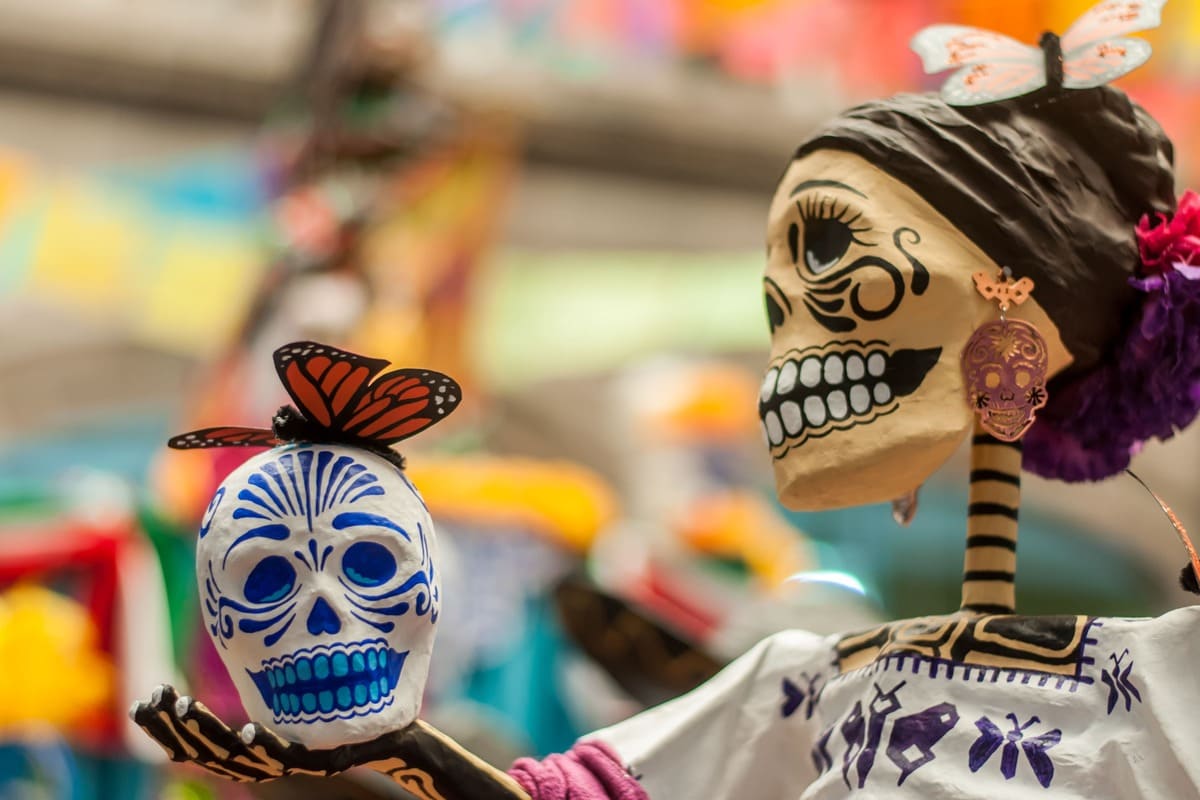It’s the Day of the Dead in Tulum! Copal incense fills the air, and sweet, fragrant “pan de muerto” delights our taste buds. Get ready for two of Mexico’s most passionate, life-celebrating holidays: Dia de los Muertos and Hanal Pixan.
While death is a taboo topic in most cultures, in Mexico we take a completely different view. Every November 1st and 2nd, we honor our departed loved ones by adorning altars with bright colors, candles, and delicious food. We believe that on these days, their spirits can return for a visit.
Streets and cemeteries transform into joyful carnivals, and we paint our faces like playful skeletons. Tears and laughter mingle as we both honor our ancestors and celebrate the mystery of life’s great cycle.
In most of Mexico, this festivity is known as “Dia de los Muertos” (Day of the Dead), but here in the south, we celebrate a slightly different, Maya version called Hanal Pixan, which lasts from Oct. 31 to Nov. 2nd. Hanal Pixan means “Feast for the Souls” in Maya.

BEAUTIFUL OFRENDAS AND A DELICIOUS FEAST:
In either festival, if you follow the trail of fragrant marigold flowers, you’ll discover lovingly decorated family and community altars. They welcome the returning souls with candles, colorful paper cut-outs, copal incense, photos of loved ones, and their favorite foods and drinks (we’ll get to that in a moment!).
Altars vary by region and family, but typically “ofrendas” (offerings) must contain elements representing fire, water, air, and earth. Here are the meanings of a few:
Candles light the way home for our loved ones
Fresh water quenches their thirst after the long journey
Salt purifies them upon arriving
Copal incense protects them from negative energies
Cempasuchil flowers celebrate the beauty of life
ANCIENT TRADITIONS TO WELCOME BACK SOULS:
Where do these traditions come from? Both festivals have roots in our Indigenous ancestors’ beliefs that death isn’t the end, and souls can return during part of the year.
The Mexica, or Aztecs, in central Mexico, dedicated several weeks a year to inviting spirits back from Mictlan, their underworld. For the Maya, our peninsula’s shimmering cenote waters were considered doors to Xibalba–the land of the afterlife.
Both cultures celebrated loved ones’ return visits with delicious special recipes, some of which we still enjoy today!
All across Mexico, these special days mean indulging in pan de muerto, bread adorned with bone-shaped decorations, and flavored with orange blossom essence and anise seeds. In many places the ofrenda also includes chicken in rich chocolatey mole sauce, and sugar skulls.
Here in the south, we also prepare Pib, a.k.a. Mucbipollo, a Maya food whose name means “something that must be buried.” Picture a huge square tamal, made with fresh corn masa, and stuffed with signature Maya ingredients: flavorful lard, bell peppers, epazote, tomatoes, onions, and fresh young espelón beans, plus juicy turkey or pork, in a sauce called Kol, made with bright red achiote seeds.
The tamal is then wrapped in giant banana leaves, and cooked underground in a huge pot, infusing it with an earthy flavor.
And don’t miss sweet and tart Xec, a tossed fruit salad made of oranges, tangerines, grapefruit, and jicama, in bitter orange juice with chile piquin and cilantro. In Maya, the word xec means “all mixed up,” and it’s used by local people to describe basically a big mess. As in, “When my little sister visited for a week, the house turned into a big xec!” Or, “This project is turning into a xec.”
CELEBRATING DIA DE LOS MUERTOS IN TULUM:
To enjoy the holiday in our region, Tulum-style, (and xec-free) here are some of our recommendations:
Come dive into the sparkling waters of our Tuuch Cenote Club with a Daypass. Swimming in this underwater wonderland, we think you’ll understand why the Maya thought of cenotes as portals to another world!
Stay overnight here at Shibari Hotel in Tulum, and immerse yourself in the sounds and sights of the ancestral Maya forest. Walk the town of Tulum to see stores’ and homes’ colorful altars decorated for the holiday, and sample some hot chocolate, or atole (a traditional corn beverage often used on ofrendas).
Enjoy our delicious artisanal pan de muerto at ATTA Restaurant.
Visit the Festival of Life and Death (Festival de Vida y Muerte) at Xcaret park. See altars, performances, traditional crafts, and sample chocolates, among other activities.
Join us at Shibari Tulum to celebrate life, honor the departed, and share the joy of living to the fullest!
Before you go, get into the Dia de los Muertos mood with this beautiful traditional song by Angela Aguilar: